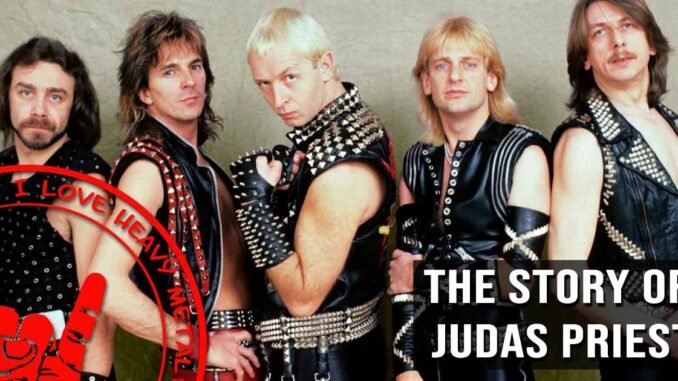
HISTORY UNCOVERED: How Judas Priest Created Heavy Metal and Started an International Movement.
When it comes to the origins of heavy metal, few names resonate as powerfully as Judas Priest. Often hailed as one of the genre’s true architects, Judas Priest didn’t just shape the sound of heavy metal—they revolutionized its aesthetic, energy, and global identity. Emerging from the gritty industrial heart of Birmingham, England, in the 1970s, they laid the foundation for what would become a global cultural force. This is the story of how Judas Priest forged heavy metal into what we know today.
The Birthplace of Metal
Birmingham was no paradise. In the shadow of steelworks and factories, the city’s working-class youth sought a way to channel their angst and frustration. From this environment came not just Judas Priest, but also Black Sabbath, another founding pillar of metal. While Sabbath leaned toward doom and gloom, Judas Priest pursued speed, aggression, and precision—elements that would come to define the genre.
Judas Priest was formed in 1969, but the lineup solidified in the early 1970s with the arrival of lead vocalist Rob Halford, guitarists K.K. Downing and Glenn Tipton, and bassist Ian Hill. Halford’s operatic vocal range, combined with Downing and Tipton’s twin guitar attack, would become the band’s signature sound—and a template for countless metal bands to come.
Redefining the Sound
By the time Judas Priest released *Sad Wings of Destiny* in 1976, they had already begun to break from the blues-based rock of their predecessors. Instead of relying on psychedelic or jam-based structures, they introduced sharp, riff-driven songs with clean, soaring vocals and dark, mythic themes. This album, featuring tracks like “Victim of Changes” and “The Ripper,” laid the groundwork for the genre’s evolution.
But it was *British Steel* (1980) that catapulted them into the mainstream and cemented their status as metal pioneers. With tracks like “Breaking the Law” and “Living After Midnight,” Judas Priest created punchy, radio-friendly anthems without sacrificing the power and attitude of metal. This was not just music—it was a rallying cry for rebellion.
Forging the Metal Image
Judas Priest didn’t just influence how metal sounded—they defined how it looked. Rob Halford’s embrace of leather, studs, and chains, inspired by the underground gay leather scene, unintentionally became the uniform of heavy metal. Fans and bands alike adopted the aesthetic, unaware of its origins, creating a new visual identity for the genre that has endured for decades.
Halford’s bold, theatrical presence challenged conventional masculinity and gave metal an edge of danger and subversion. It also offered a new kind of empowerment. The metalhead, clad in leather, was not just a fan—they were part of a tribe.
Speed and Precision
In albums like *Screaming for Vengeance* (1982) and *Defenders of the Faith* (1984), Judas Priest leaned even harder into speed and technical prowess. Songs like “Electric Eye” and “Freewheel Burning” featured blistering solos and galloping rhythms that would inspire the development of speed metal, thrash, and later, power metal.
Their influence was direct and wide-reaching. Bands such as Metallica, Slayer, and Pantera cite Judas Priest as a major influence—not just for their music, but for their work ethic and relentless touring schedule, which helped bring metal to audiences around the world.
Global Movement
Judas Priest wasn’t just an English phenomenon—they were one of the first metal bands to achieve international success. They toured the U.S., Japan, and Europe relentlessly, building a devoted global fanbase. Their anthemic songs and inclusive, high-energy performances helped create a sense of community among fans that transcended borders, language, and politics.
Heavy metal, once considered a niche subgenre, became a worldwide movement—and Judas Priest was at the helm.
Legacy and Reinvention
Despite lineup changes and changing musical landscapes, Judas Priest has remained relevant for over five decades. Albums like *Painkiller* (1990) revitalized their sound with thrash-influenced intensity, proving their ability to evolve. Halford’s public coming out in 1998 also reshaped how the metal community viewed identity and inclusivity.
In 2022, Judas Priest was finally inducted into the Rock and Roll Hall of Fame—a long-overdue recognition of their influence. They are not just survivors of the heavy metal age—they are its enduring champions.
The Verdict
Judas Priest did more than create heavy metal—they gave it a sound, a look, and a spirit. From Birmingham’s smokestacks to sold-out arenas across the globe, they transformed personal expression and defiant energy into a worldwide phenomenon. Today, whenever a power chord rings out or a fan throws up the horns, they are echoing a legacy forged by Judas Pries
t—loud, proud, and unapologetically metal.
Leave a Reply